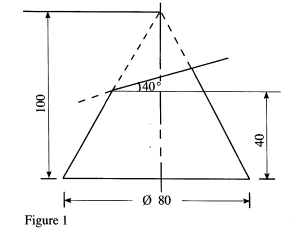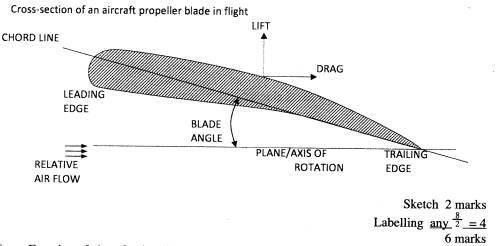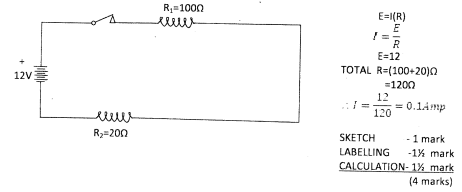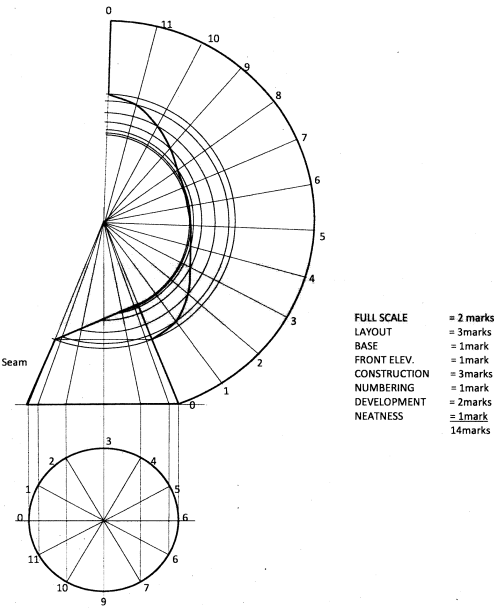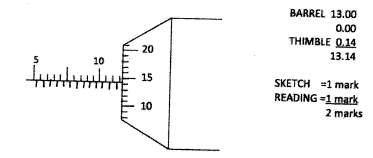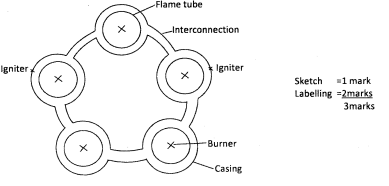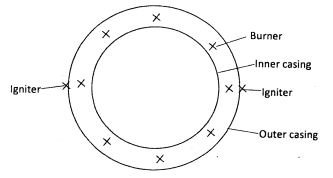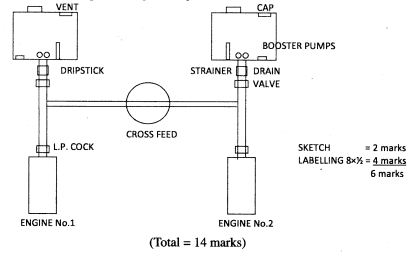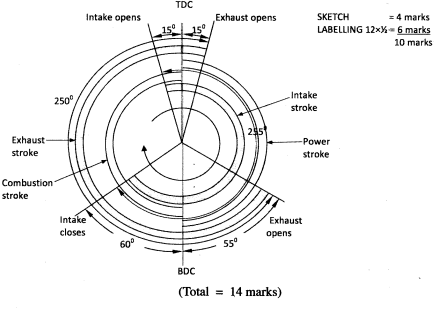SECTION A (44 marks)
Answer all the questions in this section.
-
- Define the term 'Fineness Ratio' as applied in aviation industry. (1 mark)
- Explain the term Aerofoil' as applied in aircraft industry, (2 marks)
- Differentiate between the aircraft longitudinal and directional stability in flight. (4 marks)
- With the aid of a labelled sketch, show the cross section of an aircraft propeller blade in flight. (6 marks)
-
- Outline two functions of wing ribs in an aircraft wing. (2 marks)
- Describe one basic non-destructive testing method of composite structures on an aircraft. (2 marks)
-
- List five rescue equipment carried on an aircraft. (2½ marks)
- Outline two safety aspects necessary to prevent foreign object damage during ground running of aircraft Jet Engines. (2 marks)
-
- List four ramp maintenance tasks carried out on an aircraft on transit. (2 marks)
- State three characteristics of cirrus clouds. (1½ marks)
- Outline the working environment requirements for each of the following in the aviation industry:
- lighting; (1 mark)
- noise; (1 mark)
- temperature. (1 mark)
- Explain why the following materials and hardware are used on an aircraft:
- titanium and titanium alloys; (1½marks)
- round head rivets. (1½marks)
-
- Draw a symbol for a double pole, single throw switch. (1 mark)
- A series Direct Current (DC) circuit has a voltage of 12 volts, resistance of 100Ω and 12Ω respectively.
- Draw and label the circuit. (2½ marks)
- Calculate the current flowing in the circuit. (1½marks)
- Outline four essential informations contained in a title block on a drawing. (4 marks)
- State one reason for each of the following heat treatment processes:
- Annealing;
- Case hardening: (1 mark)
- Normalizing: (1 mark)
- Tempering. (1 mark)
SECTION B (56 marks)
Answer any four out of the following five questions.
All questions carry equal marks.
- Figure 1 shows the front elevation of a truncated cone.
Draw FULL SIZE each of the following:- the base of the cone;
- the front elevation
- development of the cone. (14 marks)
(Use A3 paper provided)
-
- Explain four requirements of an engineer's steel rule. (4 marks)
- Sketch each of the following readings:
- micrometer . 13.14 mm (2 marks)
- vernier calliper (0.02) - 13.26mm (2 marks)
- With the aid of sketches, illustrate how a vernier calliper is used to measure each of the following:
- depth; (2 marks)
- internal dimension. (2 marks)
- Outline two reasons as to why a micrometer is preferred for use over a vernier calliper. (2 marks)
-
- Outline four functions of hot gases from an aircraft gas turbine engine. (4 marks)
- With the aid of labelled sketches describe the construction of each of the following types of Aerogas turbine engine combustion chambers.
- Multiple (5 marks)
- Annular (5 marks)
-
- Explain the function of each of the following elements of Instrument Landing System.
- Localizer; (1 marks)
- Glide slope; (1 marks)
- marker. (1 marks)
- Outline three sources of information received by the Radio Magnetic Indicator (3 marks)
-
- State two reasons of fuel cross-feeding on an aircraft. (2 marks)
- Illustrate a typical layout of a twin engine aircraft fuel system. (6 marks)
- Explain the function of each of the following elements of Instrument Landing System.
-
- Explain four reasons for carrying out value timing on an Aeropiston engine. (4 marks)
- Draw and label a value timing diagram of a four stroke Aeropiston engine. (10 marks)

MARKING SCHEME
- Fineness Ratio is defined as the Ratio of the chordline to the thickness of the aerofoil. (1 mark)
- Aerofoil is a device designed to produce a light reaction force when moving through a passage of air with minimum drag. (2 marks)
-
- Longitudinal stability is about the lateral axis and is provided by the horizontal stabilizer.
This refers to pitch motions where the aircraft has a tendency to keep a constant angle of attack with reference to the relative wind.
while - Directional stability is about the vertical axis provided by the vertical stabilizer. This refers to yawing motions where the aircraft attains a straight flight attitude. (4 marks
- Longitudinal stability is about the lateral axis and is provided by the horizontal stabilizer.
- Cross-section of an aircraft propeller blade in flight.
-
- Function of aircraft wing ribs.
- Give cross-section strength
- Provide shape of the wing
- Transfer the wing load from the covering skin to the spar.
- Prevention of fuel surge to intergral fuel tanks.
Any 2 x 1 = (2 marks)
- Visual and coin tapping method. This is used as an elementary to locate delamination by tapping with a coin the part being inspected and listening for debonding sound. (2 marks)
- Function of aircraft wing ribs.
-
- Rescue equipment
- Axe
- Fire extinguishers
- First Aid Kit
- Radio beacon
- Flare
- Dinghy
Any 5 x ½ = (2½ marks)
- Foreign object damage safety aspects.
- Ensure the engine guards are fitted.
- Ensure no loose articles around.
- Ensure cleanness of the running pad.
- Ensure danger zones are clear.
Any 2 x 1 = (2 marks)
- Rescue equipment
-
- Four ramp maintenance tasks:
- Servicing
- Engine starting
- Refuelling or defuelling
- Marshalling
- Releasing the aircraft.
Any 4 x ½ = (2 marks)
- Characteristics of cirrus clouds:
- wispy appearance
- very high altitude
- ice crystals
- less bumpy.
Any 3 x ½ = (1½ marks)
- Four ramp maintenance tasks:
- Working environmental requirements:
- Lighting should be adequate
- Noise should be below destruction level
- Temperature must be adequate to work without discomfort.
3x1 = (3 marks)
- Materials and hardware:
- Titanium and titanium alloys
- High melting point
- Good corrosion resistance
- Strength to weight ratio
- Machinability
Any 3 x½ = (1½marks)
- Round head rivets
Round head rivets are used on internal structures where strength is a major factor and streamlining is not important. (1½ marks)
- Titanium and titanium alloys
-
- Double pole, single throw switch.
(1 mark)
-
- Double pole, single throw switch.
- Title block on a drawing:
- Drawing number to identify the print.
- The name of the part or assembly (nomenclature) for filing purposes.
- The scale to which it is drawn.
- The date. When the date was done.
- The name of the firm.
- The name of the draftman and signature.
Any 4x1 = 4 marks
- Heat treatment processes.
- Annealing - To produce maximum softness.
- Case hardening - To produce wear resistance surface.
- Normalizing - Produce tensile strength or remove internal stresses.
- Tempering - To reduce brittleness.
4x1 = 4 marks
-
-
- Engineers steel rule requirements:
- Made from hardened and tempered corrosion resistant spring steel.
- Machine graduated so that the graduations should be precision engraved.
- Ground on the edges so that it can be used to guide in scribing lines.
- Ground on one edge so that it can be used as a zero datum.
- Chrome finished so as to remove glare.
- Parallelism on the sides to give correct measurements.
Any 4x1 = (4 marks)
-
- Micrometer reading 13.14mm
- Vernier calliper (0.02) reading 13.26mm
- Micrometer reading 13.14mm
-
- Depth measurement of a vernier calliper
- Internal measurement of a vernier calliper.
- Depth measurement of a vernier calliper
- Advantages of a micrometer over a vernier calliper.
- Micrometer is more accurate than a vernier calliper.
- Micrometer is easier to read than a vernier calliper.
- Micrometer free from parallax error.
- Micrometer has better feel than a vernier calliper.
Any 2x1 = (2 marks)
- Engineers steel rule requirements:
-
- Functions of hot gases from an aircraft gas turbine engine.
- To provide thrust and propel the aircraft forward.
- Blown through ducts for the purpose of activating.
- Blown through nozzle guide vanes for the purpose of cooling.
- For the purpose of air conditioning and pressurization
- For engine starting from a running engine.
Any 4x1 = (4 marks)
-
- Types of combustion chambers for gas turbine engines.
This consists of chambers disposed around the engine.
Each chamber has an inner flame tube around which there is an air casing
Each chamber has a burner.
There are two igniter plugs one on each side of the engine.
The chambers are connected with interconnectors to equalise pressures and propagate the flame during starting. (5 marks)
SKETCH 1 mark
ARRANGEMENT 1 mark
LABELLING 2 marks
DESCRIPTION 1 mark
(5 marks) - Annular combustion chamber
This type of combustion chamber consists of a single flame tube completely annular in form, which is contained in an inner and outer casing. The burners are suspended in the annular for supplying the fuel from the fuel manifold. There are two igniter plugs, one on each side of the engine.
SKETCH 1 mark
ARRANGEMENT 1 mark
LABELLING 2 marks
DESCRIPTION 1 mark
5 marks (10 marks) (14 marks)
- Types of combustion chambers for gas turbine engines.
- Functions of hot gases from an aircraft gas turbine engine.
-
- The function of ILS main elements:
- Localizer - The localizer provides tracking guidelines along the extend centreline of the runway. (guideline in azimuth left or right of the extended centreline)
- The glide scope. The glidescope provides vertical guidance towards the runway touch down point, usually a slope of approximately 3° to the horizontal
- The marker - The marker beacons provides accurate range fixes along the approach (usually inner, middle and outer markers). (3 marks)
- The sources of information presented on the R.M indicator dial.
- Magnetic Heading - Heading from a remote indicating compass to a particular station
- V.O.R. The bearing from a Very High Frequency Omnidirection Range (VOR) ground station.
- A.D.F. The bearing from an Automatic Direction Funding (ADF) station.
(3 marks)
-
- Fuel cross-feeding
- Incase of engine failure.
- Incase of one or more tanks failure.
- Distribution of fuel for weight and balance purposes.
Any 2 x 1 = (2 marks)
- Twin engine fuel system layout.
- Fuel cross-feeding
- The function of ILS main elements:
-
- Reasons for value timing on Aeropiston engines.
- Improve volumetric efficiency of the engine.
- Obtain maximum engine power.
- Ensure ignition occurs at the right time.
- To prevent backfiring and detonation.
- To improve the cooling of the engine.
- Ensure all the burnt out gases are expelled.
Any 4 x 1 = (4 marks)
- Engine value timing diagram
- Reasons for value timing on Aeropiston engines.
Download KCSE 2012 Aviation Technology Paper 1 with Marking Scheme.
Tap Here to Download for 50/-
Get on WhatsApp for 50/-
Why download?
- ✔ To read offline at any time.
- ✔ To Print at your convenience
- ✔ Share Easily with Friends / Students

